Punjab, India
Punjab (/pʌnˈdʒɑːb/ (![]() listen);[6] Punjabi: [pənˈdʒɑːb]) is a state in northern India. Forming part of the larger Punjab region of the Indian subcontinent, the state is bordered by the Indian states of Himachal Pradesh to the north and northeast, Haryana to the south and southeast, and Rajasthan to the southwest; by the Indian union territories of Chandigarh to the east and Jammu and Kashmir to the north. It shares an international border with Punjab, a province of Pakistan to the west.[7] The state covers an area of 50,362 square kilometres (19,445 square miles), which is 1.53% of India's total geographical area,[8] making it the 19th-largest Indian state by area out of 28 Indian states (20th largest, if UTs are considered). With over 27 million inhabitants, Punjab is the 16th-largest Indian state by population, comprising 23 districts.[1] Punjabi, written in the Gurmukhi script, is the most widely spoken and the official language of the state.[9] The main ethnic groups are the Punjabis, with Sikhs and Hindus as the dominant religious groups.[10] The state capital is Chandigarh, a union territory and also the capital of the neighbouring state of Haryana. The five tributary rivers of the Indus River from which the region takes its name are the Sutlej, the Beas, the Ravi, the Chenab and the Jhelum. Of these, the first three flow through Indian Punjab,[11] while the latter two flow entirely through Punjab, Pakistan.
listen);[6] Punjabi: [pənˈdʒɑːb]) is a state in northern India. Forming part of the larger Punjab region of the Indian subcontinent, the state is bordered by the Indian states of Himachal Pradesh to the north and northeast, Haryana to the south and southeast, and Rajasthan to the southwest; by the Indian union territories of Chandigarh to the east and Jammu and Kashmir to the north. It shares an international border with Punjab, a province of Pakistan to the west.[7] The state covers an area of 50,362 square kilometres (19,445 square miles), which is 1.53% of India's total geographical area,[8] making it the 19th-largest Indian state by area out of 28 Indian states (20th largest, if UTs are considered). With over 27 million inhabitants, Punjab is the 16th-largest Indian state by population, comprising 23 districts.[1] Punjabi, written in the Gurmukhi script, is the most widely spoken and the official language of the state.[9] The main ethnic groups are the Punjabis, with Sikhs and Hindus as the dominant religious groups.[10] The state capital is Chandigarh, a union territory and also the capital of the neighbouring state of Haryana. The five tributary rivers of the Indus River from which the region takes its name are the Sutlej, the Beas, the Ravi, the Chenab and the Jhelum. Of these, the first three flow through Indian Punjab,[11] while the latter two flow entirely through Punjab, Pakistan.
Punjab | |
|---|---|
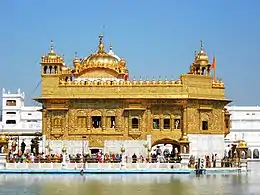 .jpg.webp)     .jpg.webp) 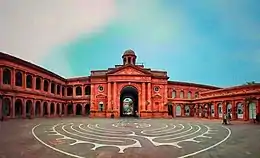 Clockwise from top: Golden Temple, Fateh Burj, Gobindgarh Fort, Qila Mubarak, Patiala, Serai Nurmahal, Punjabi folk dance - Bhangra, Jallianwala Bagh memorial, Partition Museum | |
 Emblem | |
| Etymology: Panj (means five) and āb" (means waters) | |
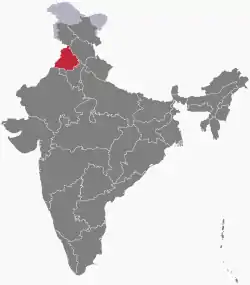 Location of Punjab in India | |
| Coordinates (Chandigarh): 30.79°N 75.84°E | |
| Country | |
| Capital | Chandigarh† |
| Largest city | Ludhiana |
| Districts | 23 |
| Government | |
| • Body | Government of Punjab |
| • Governor | Banwarilal Purohit |
| • Chief Minister | Bhagwant Mann (AAP) |
| • Legislature | Unicameral (117 seats) |
| • Parliamentary constituency | Lok Sabha (13 seats) Rajya Sabha (7 seats) |
| • High Court | Punjab and Haryana High Court†† |
| Area | |
| • Total | 50,362 km2 (19,445 sq mi) |
| • Rank | 19th out of 28 states |
| Highest elevation | 551 m (1,808 ft) |
| Lowest elevation | 150 m (490 ft) |
| Population (2011)[1] | |
| • Total | 27,743,338 |
| • Rank | 16th |
| • Density | 550/km2 (1,400/sq mi) |
| Demonym | Punjabi |
| GDP (2020–21) | |
| • Total | ₹5.42 trillion (US$68 billion) |
| • Per capita | ₹151,367 (US$1,900) |
| Time zone | UTC+05:30 (IST) |
| ISO 3166 code | IN-PB |
| HDI (2019) | |
| Literacy (2011) | 76.68% |
| Official language | Punjabi[4] |
| Website | punjab |
| Symbols of Punjab | |
| Emblem | Emblem of Punjab (Lion Capital of Ashoka with Wheat stem (above) and Crossed Swords (below)) |
| Dance | Bhangra, Giddha |
| Mammal | |
| Bird | 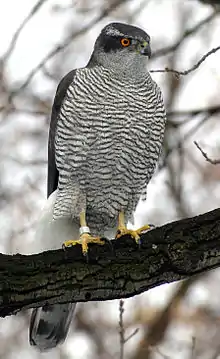 |
| Flower |  |
| Tree | |
| ^† Joint Capital with Haryana. ††Common for Punjab, Haryana and Chandigarh. | |
The history of Punjab has witnessed the migration and settlement of different tribes of people with different cultures and ideas, forming a melting pot of Punjabi civilisation. The Indus Valley civilization flourished in antiquity before recorded history until their decline around 1900 BCE.[12] Punjab was enriched during the height of the Vedic period, but declined in predominance with the rise of the Mahajanapadas.[13] The region formed the frontier of initial empires during antiquity including the Alexander's and Maurya empires.[14][15] It was subsequently conquered by the Kushan Empire, Gupta Empire,[16] and then Harsha's Empire.[17] Punjab continued to be settled by nomadic people; including the Huna, Turkic and the Mongols. Circa 1000 CE, the Punjab came under the rule of Muslims[18] and was part of the Delhi Sultanate, Mughal Empire, and Durrani Empire.[19] Sikhism was founded in the 15th to 17th centuries by the Sikh Gurus in the Punjab and resulted in the formation of the Sikh Confederacy after the fall of the Mughal Empire and ensuing conflict with the Durrani Empire.[20] This confederacy was united into the Sikh Empire in 1801 by Maharaja Ranjit Singh.[21]
The greater Punjab region was annexed by the British East India Company from the Sikh Empire in 1849.[22] Following widespread religious violence in 1947, the Punjab Province of British India was divided along religious lines into West Punjab and East Punjab.[23] The West Punjab became part of a Muslim-majority Pakistan, while the East Punjab became part of a Hindu-majority India. After the Punjabi Suba movement, the Indian Punjab and PEPSU were divided into three parts on the basis of language on 1 November 1966.[24] Haryanvi and Hindi speaking areas (including various dialects) were carved out as Haryana, while the hilly regions and Pahari-speaking areas formed Himachal Pradesh, alongside the current state of Punjab. An insurgency occurred in Punjab during the 1980s.[25] At present, the economy of Punjab is the 15th-largest state economy in India with ₹5.29 trillion (US$66 billion) in gross domestic product and a per capita GDP of ₹151,367 (US$1,900), ranking 17th amongst Indian states.[2] Since independence, Punjab is predominantly an agrarian society. It is the ninth-highest ranking among Indian states in human development index.[3] Punjab has bustling tourism, music, culinary, and film industries.[26]
Etymology
History
Background
%252C_Adhyaya_1%252C_lines_1.1.1_to_1.1.9%252C_Sanskrit%252C_Devanagari.jpg.webp)
The Punjabi people first practiced Hinduism, the oldest recorded religion in the Punjab region.[27] The historical Vedic religion constituted the religious ideas and practices in the Punjab during the Vedic period (1500–500 BCE), centered primarily in the worship of Indra.[28][29][30][31][32][lower-roman 1] The bulk of the Rigveda was composed in the Punjab region between circa 1500 and 1200 BC,[33] while later Vedic scriptures were composed more eastwards, between the Yamuna and Ganges rivers. An ancient Indian law book called the Manusmriti, developed by Brahmin Hindu priests, shaped Punjabi religious life from 200 BC onward.[34] Later, the spread of Buddhisim and Jainism in the Indian subcontinent saw the growth of Buddhism and Jainism in the Punjab.[35] Islam was introduced via southern Punjab in the 8th century, becoming the majority by the 16th century, via local conversion.[36][37] There was a small Jain community left in Punjab by the 16th century, while the Buddhist community had largely disappeared by the turn of the 10th century.[38] The region became predominantly Muslim due to missionary Sufi saints whose dargahs dot the landscape of the Punjab region.[39] The rise of Sikhism in the 1700s saw some Punjabis, both Hindu and Muslim, accepting the new Sikh faith.[34][40] A number of Punjabis during the colonial period of India became Christians, with all of these religions characterizing the religious diversity now found in the Punjab region.[34]
Sikhs in Punjab
Sikhism originated in the Punjab region of the Indian subcontinent,[lower-roman 2] around the end of the 15th century CE.[41][42][43][44][45][46] It is the most recently founded major organized faith and stands at fifth-largest worldwide,[47][48][49] with about 25–30 million adherents (known as Sikhs) as of the early 21st century.[50][51]

Sikhism developed from the spiritual teachings of Guru Nanak (1469–1539), the faith's first guru,[52] and the nine Sikh gurus who succeeded him. The tenth guru, Gobind Singh (1666–1708), named the Sikh scripture Guru Granth Sahib as his successor, bringing to a close the line of human gurus and establishing the scripture as the 11th and last eternally living guru, a religious spiritual/life guide for Sikhs.[53][54][55] Guru Nanak taught that living an "active, creative, and practical life" of "truthfulness, fidelity, self-control and purity" is above metaphysical truth, and that the ideal man "establishes union with God, knows His Will, and carries out that Will".[56] Guru Hargobind, the sixth Sikh Guru (1606–1644), established the concept of mutual co-existence of the miri ('political'/'temporal') and piri ('spiritual') realms.[57]
The Sikh scripture opens with the Mul Mantar (ਮੂਲ ਮੰਤਰ), fundamental prayer about ik onkar (ੴ, 'One God').[58][59] The core beliefs of Sikhism, articulated in the Guru Granth Sahib, include faith and meditation in the name of the one creator; divine unity and equality of all humankind; engaging in seva ('selfless service'); striving for justice for the benefit and prosperity of all; and honest conduct and livelihood while living a householder's life.[60][61][62] Following this standard, Sikhism rejects claims that any particular religious tradition has a monopoly on Absolute Truth.[lower-roman 3][63]
Sikhism emphasizes simran (ਸਿਮਰਨ, meditation and remembrance of the teachings of Gurus),[64] which can be expressed musically through kirtan, or internally through naam japna ('meditation on His name') as a means to feel God's presence. It teaches followers to transform the "Five Thieves" (i.e. lust, rage, greed, attachment, and ego).[65]
The religion developed and evolved in times of religious persecution, gaining converts from both Hinduism and Islam.[66] Mughal rulers of India tortured and executed two of the Sikh gurus—Guru Arjan (1563–1605) and Guru Tegh Bahadur (1621–1675)—after they refused to convert to Islam.[67][68][69][70][71] The persecution of Sikhs triggered the founding of the Khalsa by Guru Gobind Singh in 1699 as an order to protect the freedom of conscience and religion,[67][72] with members expressing the qualities of a Sant-Sipāhī ('saint-soldier').[73][74]
Cis-Sutlej states
The Cis-Sutlej states were a group of states in modern Punjab and Haryana states lying between the Sutlej River on the north, the Himalayas on the east, the Yamuna River and Delhi District on the south, and Sirsa District on the west. These states were ruled by the Sikh Misls[75]
Sikh Empire
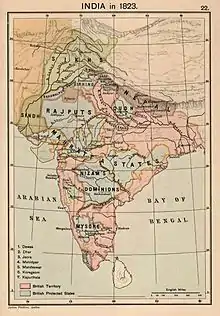

In the 19th century, Maharaja Ranjit Singh established the Sikh empire based in the Punjab.[76] The empire existed from 1799, when Ranjit Singh captured Lahore, to 1849, when it was defeated and conquered in the Second Anglo-Sikh War. It was forged on the foundations of the Khalsa from a collection of autonomous Sikh misls.[77][78] At its peak in the 19th century, the Empire extended from the Khyber Pass in the west to western Tibet in the east, and from Mithankot in the south to Kashmir in the north. It was divided into four provinces: Lahore, in Punjab, which became the Sikh capital; Multan, also in Punjab; Peshawar; and Kashmir from 1799 to 1849. Religiously diverse, with an estimated population of 3.5 million in 1831 (making it the 19th most populous country at the time),[79] it was the last major region of the Indian subcontinent to be annexed by the British Empire.
The Sikh Empire spanned a total of over 200,000 sq mi (520,000 km2) at its zenith.[80][81][82]
After Ranjit Singh's death in 1839, the empire was severely weakened by internal divisions and political mismanagement. This opportunity was used by the East India Company to launch the First and Second Anglo-Sikh Wars. The country was finally annexed and dissolved at the end of the Second Anglo-Sikh War in 1849 into separate princely states and the province of Punjab. Eventually, a Lieutenant Governorship was established in Lahore as a direct representative of the Crown.[83]: 221
Punjab Province (British India)

In British India, until the Partition of India in 1947, the Punjab Province was geographically a triangular tract of country of which the Indus River and its tributary the Sutlej formed the two sides up to their confluence, the base of the triangle in the north being the Lower Himalayan Range between those two rivers. Moreover, the province as constituted under British rule also included a large tract outside these boundaries. Along the northern border, Himalayan ranges divided it from Kashmir and Tibet. On the west it was separated from the North-West Frontier Province by the Indus, until it reached the border of Dera Ghazi Khan District, which was divided from Baluchistan by the Sulaiman Range. To the south lay Sindh and Rajputana, while on the east the rivers Jumna and Tons separated it from the United Provinces.[84] In total Punjab had an area of approximately 357 000 km square about the same size as modern day Germany, being one of the largest provinces of the British Raj.
It encompassed the present day Indian states of Punjab, Haryana, Chandigarh, Delhi, and some parts of Himachal Pradeshwhich were merged with Punjab by the British for administrative purposes (but excluding the former princely states which were later combined into the Patiala and East Punjab States Union) and the Pakistani regions of the Punjab, Islamabad Capital Territory and Khyber Pakhtunkhwa.
In 1901 the frontier districts beyond the Indus were separated from Punjab and made into a new province: the North-West Frontier Province. Subsequently, Punjab was divided into four natural geographical divisions by colonial officials on the decadal census data:[85]: 2
In March 1940, the All-India Muslim League passed the Lahore Resolution, demanding the creation of a separate state from Muslim majority areas in British India. This triggered bitter protests by the Sikhs in Punjab, who could not countenance living in a Muslim state.[86]
In 1946, massive communal tensions and violence erupted between Punjab's Muslim majority and the Hindu and Sikh minorities. The Muslim League attacked the government of Unionist Punjabi Muslims, Sikh Akalis and the Congress and led to its downfall. Unwilling to be cowed, Sikhs and Hindus counterattacked, and the resulting bloodshed left the province in great disorder. Congress and League leaders agreed to partition Punjab along religious lines, a precursor to the wider partition of the country.[87]
Independence and its aftermath
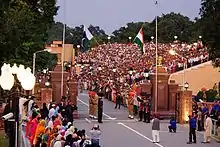

The undivided Punjab, of which Pakistani Punjab forms a major region today, was home to a large minority population of Punjabi Hindus and Sikhs until 1947, apart from the Muslim majority.[88] In 1947 the Punjab Province of British India was partitioned along religious lines into West Punjab going to Pakistan and East Punjab going to India. Huge numbers of people were displaced, and there was much intercommunal violence. Immediately following independence in 1947, and due to the ensuing communal violence and fear, most Sikhs and Punjabi Hindus who found themselves in Pakistan migrated to India.[89] Following independence, several small Punjabi princely states, including Patiala, acceded to the Union of India and were united into the PEPSU. In 1956 this was integrated with the state of East Punjab to create a new, enlarged Indian state called simply "Punjab". Punjab Day is celebrated across the state on 1 November every year marking the formation of a Punjabi language speaking state under the Punjab Reorganisation Act (1966).[90][91]
From 1981 to 1995 the state suffered a 14-year long insurgency. Problems began due to disputes between Punjabi Sikhs and the central government of the Republic of India. Tensions escalated throughout the early 1980s and eventually culminated with Operation Blue Star in 1984; an Indian Army operation aimed at the dissident Sikh community of Punjab. Shortly thereafter, Indian Prime Minister Indira Gandhi was assassinated by two of her Sikh bodyguards. The decade that followed was noted for widespread inter-communal violence and accusations of genocide on the part of the Sikh community by the Indian government.[92]
Geography
Punjab is in northwestern India and has a total area of 50,362 square kilometres (19,445 sq mi). Punjab is bordered by Pakistan's Punjab province on the west, Jammu and Kashmir on the north, Himachal Pradesh on the northeast and Haryana and Rajasthan on the south.[7] Most of Punjab lies in a fertile, alluvial plain with perennial rivers and an extensive irrigation canal system.[93] A belt of undulating hills extends along the northeastern part of the state at the foot of the Himalayas. Its average elevation is 300 metres (980 ft) above sea level, with a range from 180 metres (590 ft) in the southwest to more than 500 metres (1,600 ft) around the northeast border. The southwest of the state is semi-arid, eventually merging into the Thar Desert. Of the five Punjab rivers, three—Sutlej, Beas and Ravi—flow through the Indian state. The Sutlej and Ravi define parts of the international border with Pakistan.
The soil characteristics are influenced to a limited extent by the topography, vegetation and parent rock. The variation in soil profile characteristics are much more pronounced because of the regional climatic differences.[94] Punjab is divided into three distinct regions on the basis of soil types: southwestern, central, and eastern. Punjab falls under seismic zones II, III, and IV. Zone II is considered a low-damage risk zone; zone III is considered a moderate-damage risk zone; and zone IV is considered a high-damage risk zone.[95]
Climate
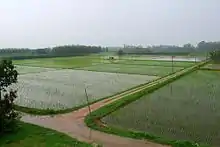
The geography and subtropical latitudinal location of Punjab lead to large variations in temperature from month to month. Even though only limited regions experience temperatures below 0 °C (32 °F), ground frost is commonly found in the majority of Punjab during the winter season. The temperature rises gradually with high humidity and overcast skies. However, the rise in temperature is steep when the sky is clear and humidity is low.[96]
The maximum temperatures usually occur in mid-May and June. The temperature remains above 40 °C (104 °F) in the entire region during this period. Ludhiana recorded the highest maximum temperature at 46.1 °C (115.0 °F) with Patiala and Amritsar recording 45.5 °C (113.9 °F). The maximum temperature during the summer in Ludhiana remains above 41 °C (106 °F) for a duration of one and a half months. These areas experience the lowest temperatures in January. The sun rays are oblique during these months and the cold winds control the temperature at daytime.[96]
Punjab experiences its minimum temperature from December to February. The lowest temperature was recorded at Amritsar (0.2 °C (32.4 °F)) and Ludhiana stood second with 0.5 °C (32.9 °F). The minimum temperature of the region remains below 5 °C (41 °F) for almost two months during the winter season. The highest minimum temperature of these regions in June is more than the daytime maximum temperatures experienced in January and February. Ludhiana experiences minimum temperatures above 27 °C (81 °F) for more than two months. The annual average temperature in the entire state is approximately 21 °C (70 °F). Further, the mean monthly temperature range varies between 9 °C (48 °F) in July to approximately 18 °C (64 °F) in November.[96]
| Month | Jan | Feb | Mar | Apr | May | Jun | Jul | Aug | Sep | Oct | Nov | Dec | Year |
|---|---|---|---|---|---|---|---|---|---|---|---|---|---|
| Record high °C (°F) | 26.8 (80.2) |
32.2 (90.0) |
36.2 (97.2) |
44.1 (111.4) |
48.0 (118.4) |
47.8 (118.0) |
45.6 (114.1) |
40.7 (105.3) |
40.6 (105.1) |
38.3 (100.9) |
34.2 (93.6) |
28.5 (83.3) |
48.0 (118.4) |
| Mean maximum °C (°F) | 23.0 (73.4) |
26.1 (79.0) |
32.0 (89.6) |
40.5 (104.9) |
44.0 (111.2) |
44.1 (111.4) |
39.8 (103.6) |
37.1 (98.8) |
36.8 (98.2) |
35.5 (95.9) |
30.5 (86.9) |
24.9 (76.8) |
45.2 (113.4) |
| Average high °C (°F) | 18.4 (65.1) |
21.7 (71.1) |
26.8 (80.2) |
34.2 (93.6) |
39.0 (102.2) |
39.0 (102.2) |
35.0 (95.0) |
34.2 (93.6) |
34.1 (93.4) |
32.0 (89.6) |
27.1 (80.8) |
21.1 (70.0) |
30.2 (86.4) |
| Average low °C (°F) | 3.4 (38.1) |
6.3 (43.3) |
10.9 (51.6) |
16.1 (61.0) |
21.3 (70.3) |
24.3 (75.7) |
25.3 (77.5) |
24.9 (76.8) |
22.1 (71.8) |
15.4 (59.7) |
8.7 (47.7) |
4.1 (39.4) |
15.2 (59.4) |
| Mean minimum °C (°F) | −0.5 (31.1) |
1.7 (35.1) |
5.6 (42.1) |
10.2 (50.4) |
15.8 (60.4) |
19.6 (67.3) |
21.7 (71.1) |
21.4 (70.5) |
17.8 (64.0) |
10.7 (51.3) |
4.2 (39.6) |
0.1 (32.2) |
−1.2 (29.8) |
| Record low °C (°F) | −2.9 (26.8) |
−2.6 (27.3) |
2.0 (35.6) |
6.4 (43.5) |
9.6 (49.3) |
15.6 (60.1) |
18.2 (64.8) |
18.8 (65.8) |
13.0 (55.4) |
7.3 (45.1) |
−0.6 (30.9) |
−3.6 (25.5) |
−3.6 (25.5) |
| Average rainfall mm (inches) | 26.2 (1.03) |
38.6 (1.52) |
38.4 (1.51) |
21.4 (0.84) |
26.7 (1.05) |
61.2 (2.41) |
210.1 (8.27) |
167.3 (6.59) |
77.5 (3.05) |
16.1 (0.63) |
6.3 (0.25) |
13.6 (0.54) |
703.4 (27.69) |
| Average rainy days | 2.1 | 3.3 | 3.2 | 2.0 | 2.4 | 3.8 | 8.6 | 6.9 | 3.5 | 1.1 | 0.6 | 1.4 | 39.0 |
| Average relative humidity (%) (at 17:30 IST) | 63 | 55 | 49 | 32 | 28 | 39 | 64 | 69 | 61 | 50 | 54 | 61 | 52 |
| Average dew point °C (°F) | 7 (45) |
10 (50) |
13 (55) |
14 (57) |
15 (59) |
20 (68) |
25 (77) |
26 (79) |
24 (75) |
18 (64) |
12 (54) |
8 (46) |
16 (61) |
| Mean monthly sunshine hours | 181.7 | 192.7 | 219.4 | 265.0 | 294.7 | 269.0 | 215.5 | 227.7 | 240.8 | 253.2 | 220.1 | 182.2 | 2,762 |
| Average ultraviolet index | 4 | 5 | 6 | 8 | 9 | 9 | 8 | 8 | 7 | 6 | 5 | 4 | 7 |
| Source 1: India Meteorological Department[97][98] Time and Date (dewpoints, 2005-2015)[99] | |||||||||||||
| Source 2: NOAA (sun 1971–1990)[100] Weather Atlas[101] | |||||||||||||
| Month | Jan | Feb | Mar | Apr | May | Jun | Jul | Aug | Sep | Oct | Nov | Dec | Year |
|---|---|---|---|---|---|---|---|---|---|---|---|---|---|
| Record high °C (°F) | 29.0 (84.2) |
30.4 (86.7) |
41.1 (106.0) |
46.1 (115.0) |
48.3 (118.9) |
47.9 (118.2) |
47.8 (118.0) |
44.4 (111.9) |
41.7 (107.1) |
40.0 (104.0) |
35.8 (96.4) |
29.4 (84.9) |
48.3 (118.9) |
| Mean maximum °C (°F) | 23.8 (74.8) |
26.9 (80.4) |
32.6 (90.7) |
40.7 (105.3) |
43.8 (110.8) |
43.5 (110.3) |
37.9 (100.2) |
35.8 (96.4) |
35.6 (96.1) |
34.7 (94.5) |
30.7 (87.3) |
25.1 (77.2) |
44.8 (112.6) |
| Average high °C (°F) | 18.6 (65.5) |
22.2 (72.0) |
27.3 (81.1) |
35.0 (95.0) |
38.9 (102.0) |
37.9 (100.2) |
34.0 (93.2) |
33.1 (91.6) |
33.0 (91.4) |
31.9 (89.4) |
27.3 (81.1) |
21.6 (70.9) |
30.1 (86.2) |
| Average low °C (°F) | 5.6 (42.1) |
8.2 (46.8) |
12.3 (54.1) |
17.7 (63.9) |
22.9 (73.2) |
25.3 (77.5) |
25.8 (78.4) |
25.1 (77.2) |
22.8 (73.0) |
16.5 (61.7) |
10.7 (51.3) |
6.5 (43.7) |
16.6 (61.9) |
| Mean minimum °C (°F) | 1.2 (34.2) |
3.4 (38.1) |
7.3 (45.1) |
12.0 (53.6) |
17.6 (63.7) |
20.5 (68.9) |
22.0 (71.6) |
21.7 (71.1) |
18.8 (65.8) |
12.6 (54.7) |
6.0 (42.8) |
2.5 (36.5) |
0.8 (33.4) |
| Record low °C (°F) | −2.2 (28.0) |
−1.1 (30.0) |
1.4 (34.5) |
7.1 (44.8) |
11.7 (53.1) |
18.0 (64.4) |
17.4 (63.3) |
18.0 (64.4) |
15.2 (59.4) |
9.4 (48.9) |
0.3 (32.5) |
−1.1 (30.0) |
−2.2 (28.0) |
| Average rainfall mm (inches) | 28.3 (1.11) |
37.0 (1.46) |
29.9 (1.18) |
17.3 (0.68) |
22.3 (0.88) |
69.2 (2.72) |
215.0 (8.46) |
205.2 (8.08) |
146.0 (5.75) |
19.8 (0.78) |
4.3 (0.17) |
15.1 (0.59) |
809.3 (31.86) |
| Average rainy days | 2.2 | 2.7 | 2.4 | 1.7 | 2.0 | 4.3 | 8.4 | 8.6 | 5.0 | 1.0 | 0.6 | 1.0 | 39.9 |
| Average relative humidity (%) (at 17:30 IST) | 63 | 54 | 46 | 25 | 23 | 41 | 67 | 73 | 65 | 49 | 49 | 63 | 51 |
| Average dew point °C (°F) | 8 (46) |
12 (54) |
15 (59) |
16 (61) |
19 (66) |
23 (73) |
26 (79) |
26 (79) |
24 (75) |
19 (66) |
13 (55) |
10 (50) |
18 (64) |
| Average ultraviolet index | 4 | 5 | 7 | 8 | 9 | 9 | 8 | 7 | 7 | 6 | 5 | 4 | 7 |
| Source 1: India Meteorological Department[102][103]Time and Date (dewpoints, 2005-2015)[104] | |||||||||||||
| Source 2: Weather Atlas[105] | |||||||||||||
Seasons
Punjab experiences three main seasons. They are:
- Summer (mid-April to the end of June)
- Monsoon (early July to the end of September)
- Winter (early December to the end of February).[96]
Apart from these three, the state experiences transitional seasons like:
Summer
Punjab starts experiencing mildly hot temperatures in February. The actual summer season commences in mid-April and the heat continues till the end of August. High temperatures between May and August hover between 40 and 47 °C. The area experiences atmospheric pressure variations during the summer months. The atmospheric pressure of the region remains around 987 millibar during February and it reaches 970 millibar in June.[96]
Monsoon
Punjab's rainy season begins in the first week of July as monsoon currents generated in the Bay of Bengal bring rain to the region. The monsoon lasts up to mid-September.[96]
Winter
Temperature variation is minimal in January. The mean night and day temperatures fall to 5 °C (41 °F) and 12 °C (54 °F), respectively.[96]
Post-Monsoon transitional season
The monsoon begins to reduce by the second week of September. This brings a gradual change in climate and temperature. The time between October and November is the transitional period between monsoon and winter seasons. Weather during this period is generally temperate and dry.[96]
Post-Winter transitional season
The effects of winter diminish by the first week of March. The hot summer season commences in mid-April. This period is marked by occasional showers with hail storms and squalls that cause extensive damage to crops. The winds remain dry and warm during the last week of March, commencing the harvest period.[96]
Rainfall
- Monsoon Rainfall
Monsoon season provides most of the rainfall for the region. Punjab receives rainfall from the monsoon current of the Bay of Bengal. This monsoon current enters the state from the southeast in the first week of July.[96]
- Winter Rainfall
The winter season remains very cool with temperatures falling below freezing at some places. Winter also brings in some western disturbances.[96] Rainfall in the winter provides relief to the farmers as some of the winter crops in the region of Shivalik Hills are entirely dependent on this rainfall. As per meteorological statistics, the sub-Shivalik area receives more than 100 millimetres (3.9 in) of rainfall in the winter months.[96]
Flora and fauna
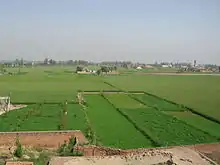
The fauna of the area is rich, with 396 types of birds, 214 kinds of Lepidoptera, 55 varieties of fish, 20 types of reptiles, and 19 kinds of mammals. The state of Punjab has large wetland areas, bird sanctuaries that house numerous species of birds, and many zoological parks. Wetlands include the national wetland Hari-Ke-Pattan, the wetland of Kanjli, and the wetlands of Kapurthala Sutlej. Wildlife sanctuaries include the Harike in the district of Tarn Taran Sahib, the Zoological Park in Rupnagar, Chhatbir Bansar Garden in Sangrur, Aam Khas Bagh in Sirhind, Amritsar's famous Ram Bagh Palace, Shalimar Garden in Kapurthala, and the famous Baradari Garden in the city of Patiala.[106]
Animals
A few of the rivers in Punjab have crocodiles. The extraction of silk from silkworms is another industry that flourishes in the state. Production of bee honey is done in some parts of Punjab. The southern plains are desert land; hence, camels can be seen. Buffaloes graze around the banks of rivers. The northeastern part is home to animals like horses. Wildlife sanctuaries have many more species of wild animals like the otter, wild boar, wildcat, fruit bat, hog deer, flying fox, squirrel, and mongoose. Naturally formed forests can be seen in the Shivalik ranges in the districts of Ropar, Gurdaspur and Hoshiarpur. Patiala is home to the Bir forest while the wetlands area in Punjab is home to the Mand forest.[107]
Botanical gardens exist throughout Punjab. There is a zoological park and a tiger safari park, as well as three parks dedicated to deer.[107]
The state bird is the northern goshawk (baz) (Accipiter gentilis),[108] the state animal is the blackbuck (Antilope cervicapra), the state aquatic animal is Indus river dolphin (Platanista minor), and the state tree is the shisham (Dalbergia sissoo).[93]
Government and politics
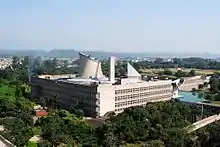
Punjab is governed through a parliamentary system of representative democracy. Each of the states of India possesses a parliamentary system of government, with a ceremonial state Governor, appointed by the President of India on the advice of the central government. The head of government is an indirectly elected Chief Minister who is vested with most of the executive powers. The term length of the government is five years. The state legislature, the Vidhan Sabha, is the unicameral Punjab Legislative Assembly, with 117 members elected from single-seat constituencies.[109] The current government was elected in the 2022 Assembly elections as Aam Aadmi Party won 92 out of 117 Assembly seats and Bhagwant Mann is the current Chief Minister. The state of Punjab is divided into five administrative divisions and twenty-two districts.
The capital of Punjab is Chandigarh, which also serves as the capital of Haryana and is thus administered separately as a Union Territory of India. The judicial branch of the state government is provided by the Punjab and Haryana High Court in Chandigarh.[110]
The three major political parties in the state are the Aam Aadmi Party, a centrist to left wing party, the Shiromani Akali Dal, a Sikh right-wing Punjabiyat party and the Indian National Congress, a centrist catch all party.[111] President's rule has been imposed in Punjab eight times so far, since 1950, for different reasons. In terms of the absolute number of days, Punjab was under the President's rule for 3,510 days, which is approximately 10 years. Much of this was in the 80s during the height of militancy in Punjab. Punjab was under the President's rule for five continuous years from 1987 to 1992.
Punjab state law and order is maintained by Punjab Police. Punjab police is headed by its DGP, Dinkar Gupta,[112] and has 70,000 employees. It manages state affairs through 22 district heads known as SSP.
Administrative set-up
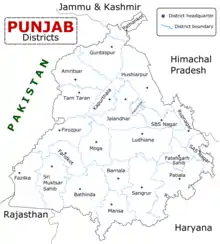
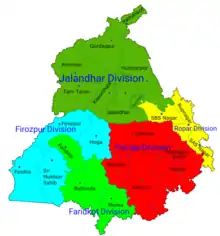
Punjab has 23 districts, which are geographically classified into Majha, Malwa, Doaba and Puadh regions, as under: -
- Majha (4)
- Amritsar
- Gurdaspur
- Pathankot
- Tarn Taran
- Doaba (4)
- Hoshiarpur
- Jalandhar
- Kapurthala
- Shaheed Bhagat Singh Nagar
- Malwa (12)
- Barnala
- Bathinda
- Ferozepur
- Fazilka
- Faridkot
- Ludhiana
- Moga
- Malerkotla
- Mansa
- Sri Muktsar Sahib
- Patiala
- Sangrur
- Puadh (3)
- SAS Nagar (Mohali)
- Rupnagar
- Fatehgarh Sahib
These districts are officially divided among 5 administrative divisions: Faridkot, Ferozepur, Jalandhar, Patiala and Ropar(created on 31 December 2010, which was a part of Patiala Division earlier).[113]
| S. No. | Name of the Division | No. of districts | Name of the Districts |
|---|---|---|---|
| 1 | Faridkot | 3 | Bathinda, Faridkot, Mansa |
| 2 | Ferozepur | 4 | Fazilka, Ferozepur, Moga, Sri Muktsar Sahib |
| 3 | Jalandhar | 7 | Amritsar, Gurdaspur, Hoshiarpur, Jalandhar, Kapurthala, Pathankot, Tarn Taran |
| 4 | Patiala | 6 | Barnala, Fatehgarh Sahib, Ludhiana, Malerkotla, Patiala, Sangrur |
| 5 | Ropar | 3 | Rupnagar, SAS Nagar, SBS Nagar |
Each district is under the administrative control of a District Collector. The districts are subdivided into 93 tehsils, which have fiscal and administrative powers over settlements within their borders, including maintenance of local land records comes under the administrative control of a Tehsildar. Each Tehsil consists of blocks which are total 150 in number. These blocks consist of revenue villages. There are total number of revenue villages in the state is 12,278. There are 23 Zila Parishads, 136 Municipal Committees and 22 Improvement Trusts looking after 143 towns and 14 cities of Punjab.
The capital city of the state is Chandigarh and largest city of the state is Ludhiana. Out of total population of Punjab, 37.48% people live in urban regions. The absolute urban population living in urban areas is 10,399,146 of which 5,545,989 are males and while remaining 4,853,157 are females. The urban population in the last 10 years has increased by 37.48%. The major cities are Ludhiana, Amritsar, Jalandhar, Mohali, Patiala and Bathinda.
Economy

Punjab's GDP is ₹5.42 trillion (US$68 billion).[2] Punjab is one of the most fertile regions in India. The region is ideal for wheat-growing. Rice, sugar cane, fruits and vegetables are also grown. Indian Punjab is called the "Granary of India" or "India's bread-basket".[114] It produces 10.26% of India's cotton, 19.5% of India's wheat, and 11% of India's rice. The Firozpur and Fazilka Districts are the largest producers of wheat and rice in the state. In worldwide terms, Indian Punjab produces 2% of the world's cotton, 2% of its wheat and 1% of its rice.[114]
Punjab ranked first in GDP per capita amongst Indian states in 1981 and fourth in 2001, but has experienced slower growth than the rest of India, having the second-slowest GDP per capita growth rate of all Indian states and UTs between 2000 and 2010, behind only Manipur.[115][116][117][118][119][120][121] Punjab's economy has been primarily agriculture-based since the Green Revolution due to the presence of abundant water sources and fertile soils;[122] most of the state lies in a fertile alluvial plain with many rivers and an extensive irrigation canal system.[93] The largest cultivated crop is wheat. Other important crops are rice, cotton, sugarcane, pearl millet, maize, barley and fruit. Rice and wheat are doublecropped in Punjab with rice stalks being burned off over millions of acres prior to the planting of wheat. This widespread practice is polluting and wasteful.[123] Despite covering only 1.53%[8] of its geographical area, Punjab makes up for about 15-20%[124][125][126][127] of India's wheat production, around 12%[128][129][130][131] of its rice production, and around 5%[124][132][133][134] of its milk production, being known as India's breadbasket.[135][136] About 80%[137]-95%[138] of Punjab's agricultural land is owned by its Jat Sikh community despite it only forming 21%[139] of the state's population. About 10% of Punjab's population is made up of migrants from poorer states to the southeast such as Uttar Pradesh and Bihar who work as farm labourers.[140]
Other major industries include financial services, the manufacturing of scientific instruments, agricultural goods, electrical goods, machine tools, textiles, sewing machines, sports goods, starch, fertilisers, bicycles, garments, and the processing of pine oil and sugar.[136] Minerals and energy resources also contribute to Punjab's economy to a much lesser extent. Punjab has the largest number of steel rolling mill plants in India, which are in "Steel Town"—Mandi Gobindgarh in the Fatehgarh Sahib district. Punjab also has a large diaspora that is mostly settled in the United Kingdom, the United States, and Canada, numbers about 3 million, and sends back billions of USD in remittances to the state, playing a major role in its economy.[141]
In Punjab the consumption of fertiliser per hectare is 223.46 kg as compared to 90 kg nationally. The state has been awarded the National Productivity Award for agriculture extension services for ten years, from 1991 to 1992 to 1998–99 and from 2001 to 2003–04. In recent years a drop in productivity has been observed, mainly due to falling fertility of the soil. This is believed to be due to excessive use of fertilisers and pesticides over the years. Another worry is the rapidly falling water table on which almost 90% of the agriculture depends; alarming drops have been witnessed in recent years. By some estimates, groundwater is falling by a meter or more per year.[142][143]
According to the India State Hunger Index, Punjab has the lowest level of hunger in India.[144]
Transport
Air
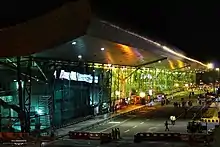
Sri Guru Ram Dass Jee International Airport in Amritsar, is the Primary Hub Airport and Gateway to Punjab, as the airport serves direct connectivity to key cities around the world, including London, Singapore, Moscow, Dubai, Birmingham among others.
Punjab has six civil airports including two international airports: Amritsar International Airport and Chandigarh International Airport at Mohali; and four domestic airports: Bathinda Airport, Pathankot Airport, Adampur Airport (Jalandhar) and Sahnewal Airport (Ludhiana). Apart from these 6 airports, there are 2 airfields at Beas (Amritsar) and Patiala which do not serve any commercial flight operations, as of now.
Railways
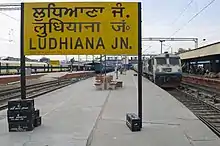
The Indian Railways' Northern Railway line runs through the state connecting most of the major towns and cities. The Shatabdi Express, India's fastest series of train connects Amritsar to New Delhi covering total distance of 449 km. Amritsar Junction Railway Station is the busiest junction of the state. Bathinda Junction holds the record of maximum railway lines from a railway junction in Asia. Punjab's major railway stations are Amritsar Junction (ASR), Ludhiana Junction (LDH), Jalandhar Cantonment (JRC), Firozpur Cantonment (FZR), Jalandhar City Junction (JUC), Pathankot Junction (PTK) and Patiala railway station (PTA). The railway stations of Amritsar is included in the Indian Railways list of 50 world-class railway stations.[145]
Hyperloop
Punjab Government have signed a MoU ( Memorendum of Understanding) with Virgin Hyperloop One to explore the feasibility of running a Hyperloop between Amritsar and Chandigarh which could decrease the travel time between 2 cities from five hours by road to less than 30 minutes. It will have stops in Ludhiana and Jalandhar.[146]
Roads
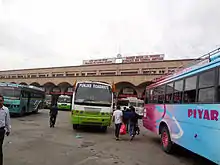
All the cities and towns of Punjab are connected by four-lane national highways. The Grand Trunk Road, also known as "NH1", connects Kolkata to Peshawar, passing through Amritsar and Jalandhar. National highways passing through the state are ranked the best in the country with widespread road networks that serve isolated towns as well as the border region. Amritsar and Ludhiana are among several Indian cities that have the highest accident rates in India.[147]
The following expressways will pass through Punjab:
The following national highways connect major towns, cities and villages:
- National Highway 1
- National Highway 10
- National Highway 15
- National Highway 1A
- National Highway 54
- National Highway 20
- National Highway 21
- National Highway 22
- National Highway 64
- National Highway 70
- National Highway 71
- National Highway 95
Urban Rapid Transit System
There are also a bus rapid transit system Amritsar BRTS in the holy city of Amritsar, popularly known as 'Amritsar MetroBus'[148]
Demographics
| Year | Pop. | ±% |
|---|---|---|
| 1901 | 7,544,790 | — |
| 1911 | 6,731,510 | −10.8% |
| 1921 | 7,152,811 | +6.3% |
| 1931 | 8,012,325 | +12.0% |
| 1941 | 9,600,236 | +19.8% |
| 1951 | 9,160,500 | −4.6% |
| 1961 | 11,135,069 | +21.6% |
| 1971 | 13,551,060 | +21.7% |
| 1981 | 16,788,915 | +23.9% |
| 1991 | 20,281,969 | +20.8% |
| 2001 | 24,358,999 | +20.1% |
| 2011 | 27,743,338 | +13.9% |
| source:Census of India[149] | ||
Punjab is home to 2.30% of India's population; with a density of 551 persons per km2. According to the provisional results of the 2011 national census, Punjab has a population of 27,743,338, making it the 16th most populated state in India. Of which male and female are 14,639,465 and 13,103,873, respectively.[150] 32% of Punjab's population consists of Dalits.[151] In the state, the rate of population growth is 13.89% (2011), lower than national average. Out of total population, 37.48% people live in urban regions. The total figure of population living in urban areas is 10,399,146 of which 5,545,989 are males and while remaining 4,853,157 are females. The urban population in the last 10 years has increased by 37.48%.
Punjabi is the sole official language of Punjab and is spoken by the majority of the population numbering around 24,919,067 constituting (89.82%) of the population as of 2011 census report. Hindi is second largest language, spoken by 2,177,853 constituting 7.85% of the population and rest 646,418 spoke's other Indian languages comprising 2.83% in other category.[152] The 2011 Census of India found Scheduled Castes to account for 31.9% of the state's population.[154] The Other Backward Classes have 31.3% population in Punjab.[155] The exact population of Forward castes is not known as their data from Socio Economic and Caste Census 2011 is not made public as of 2019.[156]
There has been a constant decline in the sex ratio of the state. The sex ratio in Punjab was 895 females per 1000 males, which was below the national average of 940. The literacy rate rose to 75.84% as per 2011 population census. Of that, male literacy stands at 80.44% while female literacy is at 70.73%. In actual numbers, total literates in Punjab stands at 18,707,137 of which males were 10,436,056 and females were 8,271,081.
Religion
Religion in Punjab (2011)[10]
Punjab has the largest population of Sikhs in India and is the only state where Sikhs form a majority, numbering around 16 million forming 57.69% of the state population.[10] Hinduism is the second largest religion in the Indian state of Punjab numbering around 10.68 million and forming 38.49% of the state's population and a majority in Doaba region. Islam is followed by 535,489 accounting 1.93% of the population and are mainly concentrated in Malerkotla and Qadian. Other smaller segments of religions existing in Punjab are Christianity practised by 1.26%, Jainism practised by 0.16%, Buddhism practised by 0.12% and others 0.36%. Sikhs form a majority in 17 districts out of the total 23 districts while Hindus form the majority in 5 districts namely, Pathankot, Jalandhar, Hoshiarpur, Fazilka and Shaheed Bhagat Singh Nagar districts.[157]

The Sikh shrine, Golden Temple (Harmandir Sahib), is in the city of Amritsar, which houses the Shiromani Gurdwara Parbandhak Committee, the topmost Sikh religious body. The Sri Akal Takht Sahib, which is within the Golden Temple complex, is the highest temporal seat of Sikhs. Of the five Takhts (Temporal Seats of religious authority) of Sikhism, three are in Punjab. These are Sri Akal Takht Sahib, Damdama Sahib and Anandpur Sahib. At least one Sikh Gurdwara can be found in almost every village in the state, as well as in the towns and cities (in various architectural styles and sizes). Due to the non-exclusive nature of their religion, a segment of Punjabis who are categorised as Punjabi Hindus continue heterogeneous religious practices in spiritual kinship with Sikhism. This not only includes veneration of the Sikh Gurus in private practice but also visits to Sikh Gurdwaras in addition to Hindu temples.[158]
Education
Primary and Secondary education is mainly affiliated to Punjab School Education Board. Punjab is served by several institutions of higher education, including 23 universities that provide undergraduate and postgraduate courses in all the major arts, humanities, science, engineering, law, medicine, veterinary science, and business. Reading and writing Punjabi language is compulsory till matriculation for every student[159] failing which the schools attract fine or cancellation of licence.[160]
Punjab Agricultural University is a leading institution globally for the study of agriculture and played a significant role in Punjab's Green Revolution in the 1960s–70s. Alumni of the Panjab University, Chandigarh include Manmohan Singh, the former Prime Minister of India, and Dr. Har Gobind Khorana, a biochemistry nobel laureate. One of the oldest institutions of medical education is the Christian Medical College, Ludhiana, which has existed since 1894.[161] There is an existing gap in education between men and women, particularly in rural areas of Punjab. Of a total of 1 million 300 thousand students enrolled in grades five to eight, only 44% are women.[162]
Punjab has 23 universities, of which ten are private, 9 are state, one is central and three are deemed universities. Punjab has 104,000 (104,000) engineering seats.[163]
Punjab is also increasingly becoming known for education of yoga and naturopathy, with its student slowly adopting these as their career. The Board of Naturopathy and Yoga Science (BNYS) is located in the state.[164] Regional College Dinanagar is the first college to be opened in Dinanagar Town.[165]
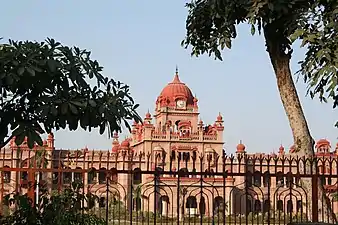 Khalsa College, Amritsar
Khalsa College, Amritsar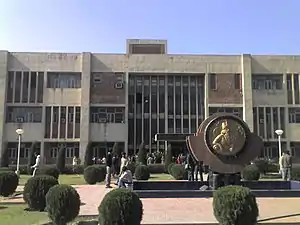 The Ranjit Singh Block at Guru Nanak Dev University
The Ranjit Singh Block at Guru Nanak Dev University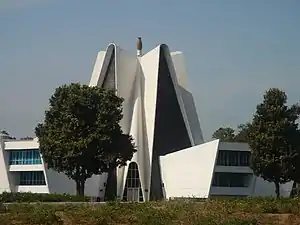 Guru Gobind Singh Bhawan at Punjabi University
Guru Gobind Singh Bhawan at Punjabi University
Media
Daily Ajit, Jagbani and Punjabi Tribune are the largest-selling Punjabi newspapers while The Tribune is most selling English newspaper. A vast number of weekly, biweekly and monthly magazines are under publication in Punjabi. Other main newspapers are Daily Punjab Times, Rozana Spokesman, Nawan Zamana, etc.
Doordarshan is the broadcaster of the Government of India and its channel DD Punjabi is dedicated to Punjabi. Prominent private Punjabi channels include news channels like BBC Punjabi,[166] ABP Sanjha,[167] Global Punjab TV,[168] News18 Punjab-Haryana-Himachal,[169] Zee Punjab Haryana Himachal, PTC News and entertainment channels like Zee Punjabi, GET Punjabi, ETC Punjabi, Chardikla Time TV, PTC Punjabi, Colours Punjabi, JUS Punjabi, MH1 and 9x Tashan.[170]
Punjab has witnessed a growth in FM radio channels, mainly in the cities of Jalandhar, Patiala and Amritsar, which has become hugely popular. There are government radio channels like All India Radio, Jalandhar, All India Radio, Bathinda and FM Gold Ludhiana.[171] Private radio channels include Radio Mirchi, BIG FM 92.7, 94.3 My FM, Radio Mantra and many more.
Culture

The culture of Punjab has many elements including music such as bhangra, an extensive religious and non-religious dance tradition, a long history of poetry in the Punjabi language, a significant Punjabi film industry that dates back to before Partition, a vast range of cuisine, which has become widely popular abroad, and a number of seasonal and harvest festivals such as Lohri,[172] Basant, Vaisakhi and Teeyan,[173][174][175] all of which are celebrated in addition to the religious festivals of India.
A kissa is a Punjabi language oral story-telling tradition that has a mixture of origins ranging from the Arabian peninsula to Iran and Afghanistan.[176]
Punjabi wedding traditions and ceremonies are a strong reflection of Punjabi culture. Marriage ceremonies are known for their rich rituals, songs, dances, food and dresses, which have evolved over many centuries.[177][178]
Bhangra
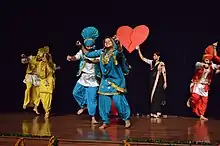
Bhangra (Punjabi: ਭੰਗੜਾ (Gurmukhi); pronounced [pɑ̀ŋɡɾɑ̀ː]) and Giddha are forms of dance and music that originated in the Punjab region.[179]
Bhangra dance began as a folk dance conducted by Punjabi farmers to celebrate the coming of the harvest season. The specific moves of Bhangra reflect the manner in which villagers farmed their land. This hybrid dance became Bhangra. The folk dance has been popularised in the western world by Punjabis in England, Canada and the USA where competitions are held.[180] It is seen in the West as an expression of South Asian culture as a whole.[181] Today, Bhangra dance survives in different forms and styles all over the globe – including pop music, film soundtracks, collegiate competitions and cultural shows.
Punjabi folklore
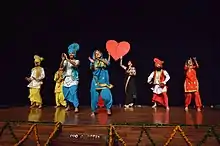
The folk heritage of the Punjab reflects its thousands of years of history. While Majhi is considered to be the standard dialect of Punjabi language, there are a number of Punjabi dialects through which the people communicate. These include Malwai, Doabi and Puadhi. The songs, ballads, epics and romances are generally written and sung in these dialects.
There are a number of folk tales that are popular in Punjab. These are the folk tales of Mirza Sahiban, Heer Ranjha, Sohni Mahiwal, Sassi Punnun, Jagga Jatt, Dulla Bhatti, Puran Bhagat, Jeona Maud etc. The mystic folk songs and religious songs include the Shalooks of Sikh gurus, Baba Farid and others.[182]
The most famous of the romantic love songs are Mayhiah, Dhola and Boliyan.[183] Punjabi romantic dances include Dhamaal, Bhangra, Giddha, Dhola, and Sammi and some other local folk dances.[184]
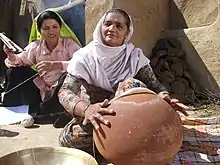
Literature
Most early Punjabi literary works are in verse form, with prose not becoming more common until later periods. Throughout its history, Punjabi literature has sought to inform and inspire, educate and entertain. The Punjabi language is written in several different scripts, of which the Shahmukhi, the Gurmukhī scripts are the most commonly used.[185]
Music
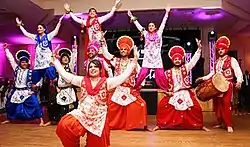
Punjabi Folk Music is the traditional music on the traditional musical instruments of Punjab region.[186][187][188]
Bhangra music of Punjab is famous throughout the world.[26]
Punjabi music has a diverse style of music, ranging from folk and Sufi to classical, notably the Punjab gharana and Patiala gharana.[189][190]
Film industry
Punjab is home to the Punjabi film industry, often colloquially referred to as 'Pollywood'.[191] It is known for being the fastest growing film industry in India. It is based mainly around Mohali city. According to MP Manish Tewari, the government is planning to build a film city in Mohali.[192]
The first Punjabi film was made in 1936. Since the 2000s Punjabi cinema has seen a revival with more releases every year with bigger budgets, homegrown stars, and Bollywood actors of Punjabi descent taking part.
Crafts
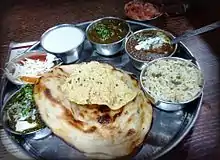
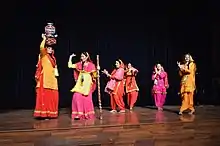
The city of Amritsar is home to the craft of brass and copper metalwork done by the Thatheras of Jandiala Guru, which is enlisted on the UNESCO's List of Intangible Cultural Heritage.[193] Years of neglect had caused this craft to die out, and the listing prompted the Government of Punjab to undertake a craft revival effort under Project Virasat.[194][195]
Cuisine
One of the main features of Punjabi cuisine is its diverse range of dishes.[196][197] Home cooked and restaurant cuisine sometimes vary in taste. Restaurant style uses large amounts of ghee. Some food items are eaten on a daily basis while some delicacies are cooked only on special occasions.[198]
There are many regional dishes that are famous in some regions only. Many dishes are exclusive to Punjab, including Sarson Da Saag, Tandoori chicken, Shami kebab, makki di roti, etc.[199]
Festivals and traditions
Punjabis celebrate a number of festivals, which have taken a semi-secular meaning and are regarded as cultural festivals by people of all religions. Some of the festivals are Bandi Chhor Divas (Diwali),[200][201] Mela Maghi,[202] Hola Mohalla,[203][204] Rakhri, Vaisakhi, Lohri, Gurpurb, Guru Ravidass Jayanti, Teeyan and Basant Kite Festival.
Sports

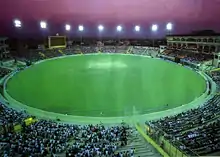
Kabbadi (Circle Style), a team contact sport originated in rural Punjab is recognised as the state game.[205][206] Field hockey is also a popular sport in the state.[207] Kila Raipur Sports Festival, popularly known as the Rural Olympics, is held annually in Kila Raipur (near Ludhiana). Competition is held for major Punjabi rural sports, include cart-race, rope pulling. Punjab government organises World Kabaddi League,[208][209]
Punjab Games and annual Kabaddi World Cup for Circle Style Kabbadi in which teams from countries like Argentina, Canada, Denmark, England, India, Iran, Kenya, Pakistan, Scotland, Sierra Leone, Spain and United States participated. A major C.B.S.E event C.B.S.E Cluster Athlectics also held in Punjab at Sant Baba Bhag Singh University.[210]
The Punjab state basketball team won the National Basketball Championship on many occasions, most recently in 2019 and 2020.[211][212]
Tourism

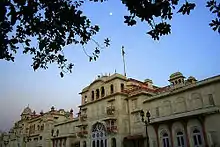
Tourism in Indian Punjab centres around the historic palaces, battle sites, and the great Sikh architecture of the state and the surrounding region.[213] Examples include various sites of the Indus Valley civilization, the ancient fort of Bathinda, the architectural monuments of Kapurthala, Patiala, and Chandigarh, the modern capital designed by Le Corbusier.[214]
The Golden Temple in Amritsar is one of the major tourist destinations of Punjab and indeed India, attracting more visitors than the Taj Mahal. Lonely Planet Bluelist 2008 has voted the Harmandir Sahib as one of the world's best spiritual sites.[215] Moreover, there is a rapidly expanding array of international hotels in the holy city at Heritage Walk Amritsar that can be booked for overnight stays. Devi Talab Mandir is a Hindu temple located in Jalandhar. This temple is devoted to Goddess Durga[216] and is believed to be at least 200 years old. Another main tourist destination is religious and historic city of Sri Anandpur Sahib where large number of tourists come to see the Virasat-e-Khalsa (Khalsa Heritage Memorial Complex) and also take part in Hola Mohalla festival. Kila Raipur Sports Festival is also popular tourist attraction in Kila Raipur near Ludhiana.[217][218][219] Shahpur kandi fort, Ranjit Sagar lake and Sikh Temple in Sri Muktsar Sahib are also popular attractions in Punjab. Punjab also has the world's first museum based on the Indian Partition of 1947, in Amritsar, called the Partition Museum.[220]
See also
- List of people from Punjab (India)
- Punjabi nationalism
- Sikh Light Infantry
- Punjab Regiment
- Sikh Regiment
- Punjabi culture
- Provinces of India (British)
- COVID-19 pandemic in Punjab, India
Notes
- Michaels (2004, p. 38): "The legacy of the Vedic religion in Hinduism is generally overestimated. The influence of the mythology is indeed great, but the religious terminology changed considerably: all the key terms of Hinduism either do not exist in Vedic or have a completely different meaning. The religion of the Veda does not know the ethicised migration of the soul with retribution for acts (karma), the cyclical destruction of the world, or the idea of salvation during one's lifetime (jivanmukti; moksa; nirvana); the idea of the world as illusion (maya) must have gone against the grain of ancient India, and an omnipotent creator god emerges only in the late hymns of the rgveda. Nor did the Vedic religion know a caste system, the burning of widows, the ban on remarriage, images of gods and temples, Puja worship, Yoga, pilgrimages, vegetarianism, the holiness of cows, the doctrine of stages of life (asrama), or knew them only at their inception. Thus, it is justified to see a turning point between the Vedic religion and Hindu religions."
Jamison, Stephanie; Witzel, Michael (1992). "Vedic Hinduism" (PDF). Harvard University. p. 3.: "... to call this period Vedic Hinduism is a contradictio in terminis since Vedic religion is very different from what we generally call Hindu religion – at least as much as Old Hebrew religion is from medieval and modern Christian religion. However, Vedic religion is treatable as a predecessor of Hinduism."
See also Halbfass 1991, pp. 1–2 - "Hinduism, Buddhism, Jainism and Sikh originated in India."Moreno, Luis; Colino, César (2010). Diversity and Unity in Federal Countries. McGill Queen University Press. p. 207. ISBN 978-0-7735-9087-8.
- "Sikhism rejects the view that any particular religious tradition has a monopoly regarding Absolute Truth. Sikhism rejects the practice of converting people to other religious traditions." Kalsi, Sewa Singh (2008). Sikhism. London: Kuperard. p. 24. ISBN 978-1-85733-436-4.
References
- "Area, population, decennial growth rate and density for 2001 and 2011 at a glance for Punjab and the districts: provisional population totals paper 1 of 2011: Punjab". Registrar General & Census Commissioner, India. Archived from the original on 7 January 2012. Retrieved 26 January 2012.
- "Handbook of Statistics of Indian States" (PDF). Reserve Bank of India. pp. 37–42. Retrieved 11 February 2022.
- "Sub-national HDI - Area Database". Global Data Lab. Institute for Management Research, Radboud University. Archived from the original on 23 September 2018. Retrieved 25 September 2018.
- "Report of the Commissioner for linguistic minorities: 50th report (July 2012 to June 2013)" (PDF). Commissioner for Linguistic Minorities, Ministry of Minority Affairs, Government of India. Archived from the original (PDF) on 8 July 2016. Retrieved 4 December 2016.
- "State Bird is BAAZ". Archived from the original on 14 July 2014.
- Also /ˈpʌndʒæb/ and other variants
- "Border Area Development Programmes in Punjab" (PDF). Department of Planning Punjab. Archived (PDF) from the original on 10 September 2016. Retrieved 22 March 2017.
- "Official site of the Ministry of Statistics and Programme Implementation, India". Archived from the original on 3 December 2013. Retrieved 20 July 2013.
- —"Report of the Commissioner for linguistic minorities: 50th report (July 2012 to June 2013)" (PDF). Commissioner for Linguistic Minorities, Ministry of Minority Affairs, Government of India. Archived from the original (PDF) on 8 July 2016. Retrieved 4 December 2016.
—"Language – India, States and Union Territories" (PDF). Census of India 2011. Office of the Registrar General. pp. 13–14. Retrieved 19 October 2018.
—"C-16 Population By Mother Tongue - Punjab". censusindia.gov.in. Retrieved 16 March 2020. - "Population by religion community – 2011". The Registrar General & Census Commissioner, India. Archived from the original on 23 September 2015.
- Encyclopædia Britannica, 9th ed., vol. 20, Punjab, p.107
- Singh, Mohinder (1988). History and Culture of Panjab. Atlantic Publishers. pp. 1, 12.
- Chattopadhyaya, Brajadulal (2003). Studying Early India: Archaeology, Texts, and Historical Issues. Permanent Black Publishers. ISBN 81-7824-143-9.
- Romm, James S. (2012). The Landmark Arrian: The Campaigns of Alexander. Anchor Books. ISBN 978-1-4000-7967-4.
- Thorpe, Showick; Thorpe, Edgar (2009). The Pearson General Studies Manual 2009. Pearson. ISBN 978-81-317-2133-9.
- Daniélou, Alain (2003). A Brief History of India. Simon and Schuster. ISBN 978-0-89281-923-2.
- Majumdar, R. C. (1977). Ancient India. Motilal Banarsidass. ISBN 978-81-208-0436-4.
- Mohan, R. T. (2010). Afghanistan Revisited: The Brahmana Hindu Shahis of Afghanistan and the Punjab ( C.840.-1026 CE). MLBD.
- —Lapidus, I. M. (2014). A History of Islamic Societies. Cambridge University Press. ISBN 978-1-139-99150-6.
—Jayapalan, N. (2001). History of India. Atlantic Publishers & Distributors (P) Limited. ISBN 978-81-7156-928-1.
—The Islamic World to 1600: Rise of the Great Islamic Empires (The Mughal Empire) Archived 27 September 2011 at the Wayback Machine
—"Mughal Dynasty". Encyclopaedia Britannica. Britannica. Retrieved 15 February 2018.
—Potdar, Datto Vaman (1938). All India Modern History Congress. - —Melton, J. G. (2014). Faiths Across Time: 5,000 Years of Religious History. ABC-CLIO. ISBN 978-1-61069-026-3.
—Jestice, Phyllis (2004). Holy people of the world : a cross-cultural encyclopedia. ABC-CLIO. ISBN 978-1-57607-355-1. OCLC 57407318.
—Latif, Syad Muhammad (1964). The History of Punjab from the Remotest Antiquity to the Present Time. Eurasia Publishing House (Pvt.) Ltd. p. 283.
—Bhatia, Sardar Singh (1998). The Encyclopedia of Sikhism, Volume IV. Punjabi University. p. 396. - Grewal, J. S.; Johnson, Gordon (1990). The Sikhs of the Punjab. Cambridge University Press. ISBN 978-0-521-26884-4.
- Cunningham, Joseph (1853). Cunningham's history of the Sikhs. Retrieved 24 July 2015.
- —Talbot, Ian (2009). "Partition of India: The Human Dimension". Cultural and Social History. 6 (4): 403–410. doi:10.2752/147800409X466254. S2CID 147110854.
The number of casualties remains a matter of dispute, with figures being claimed that range from 200,000 to 2 million victims.
—D'Costa, Bina (2011). Nationbuilding, Gender and War Crimes in South Asia. Routledge. p. 53. ISBN 978-0415565660.
—Butalia, Urvashi (2000). The Other Side of Silence: Voices From the Partition of India. Duke University Press.
—Sikand, Yoginder (2004). Muslims in India Since 1947: Islamic Perspectives on Inter-Faith Relations. Routledge. p. 5. ISBN 978-1134378258.
—"A heritage all but erased". The Friday Times. 25 December 2015. Retrieved 26 June 2017. - Brass, Paul R. (2005). Language, Religion and Politics in North India. iUniverse. p. 326. ISBN 978-0-595-34394-2.
- Mahmood, Cynthia Keppley (1996). Fighting for Faith and Nation: Dialogues with Sikh Militants. University of Pennsylvania Press. p. 77. ISBN 9780812215922. Retrieved 8 July 2018.
- —"How Punjab became home to India's largest non-film music industry". The Economic Times. 8 July 2018. Retrieved 2 July 2020.
—"Why Punjabi music is so euphonic". Business Standard. 3 May 2020. Retrieved 2 July 2020.
—"Everyone's a rockstar in Mohali, the city at the heart of a Punjabi music boom". Hindustan Times. 8 January 2019. Retrieved 2 July 2020.
—"Indian Films by Language" (PDF). Film Federation of India. Archived from the original (PDF) on 17 July 2021. Retrieved 2 July 2020.
—"Kirron Kher tries to get film city for Chandigarh". Archived from the original on 13 November 2014.
—"Kirron Kher is trying to bring a film city to Chandigarh". Archived from the original on 31 October 2015.
—"The Globalisation of Bhangra Music". Archived from the original on 10 September 2015.
—"The Bhangra Breakdown – June 2014 Edition". June 2014. Archived from the original on 28 January 2016. Retrieved 3 January 2017. - Nayar, Kamala Elizabeth (2012). The Punjabis in British Columbia: Location, Labour, First Nations, and Multiculturalism. McGill-Queen's Press - MQUP. ISBN 978-0-7735-4070-5.
- Wheeler, James Talboys (1874). The History of India from the Earliest Ages: Hindu Buddhist Brahmanical revival. N. Trübner. p. 330.
The Punjab, to say the least, was less Brahmanical. It was an ancient centre of the worship of Indra, who was always regarded as an enemy by the Bráhmans; and it was also a stronghold of Buddhism.
- Sullivan, Bruce M. (2001). The A to Z of Hinduism. Bruce M. Sullivan. Lanham, Md.: Scarecrow Press. p. 9. ISBN 0-8108-4070-7. OCLC 46732488.
- Michaels, Axel (2004). Hinduism. Past and present. Princeton, New Jersey: Princeton University Press. p. 38.
- Encyclopedia of religion. Lindsay Jones, Mircea Eliade, Charles J. Adams (2nd ed.). Detroit: Macmillan Reference USA. 2005. pp. 9552–9553. ISBN 0-02-865733-0. OCLC 56057973.
{{cite book}}: CS1 maint: others (link) - Samuel, Geoffrey (2010). The origins of yoga and tantra : Indic religions to the thirteenth century. Cambridge University Press. pp. 97–99, 113–118. ISBN 978-0-521-69534-3. OCLC 781947262.
- Flood, Gavin (13 July 1996). An Introduction to Hinduism. Cambridge University Press. ISBN 978-0-521-43878-0.
- Nayar, Kamala Elizabeth (2012). The Punjabis in British Columbia: Location, Labour, First Nations, and Multiculturalism. McGill-Queen's Press - MQUP. pp. 7–8. ISBN 978-0-7735-4070-5.
- "In ancient Punjab, religion was fluid, not watertight, says Romila Thapar". The Indian Express. 3 May 2019.
Thapar said Buddhism was very popular in Punjab during the Mauryan and post-Mauryan period. Bookended between Gandhara in Taxila on the one side where Buddhism was practised on a large scale and Mathura on another side where Buddhism, Jainism and Puranic religions were practised, this religion flourished in the state. But after the Gupta period, Buddhism began to decline.
{{cite web}}: CS1 maint: url-status (link) - Rambo, Lewis R.; Farhadian, Charles E. (6 March 2014). The Oxford Handbook of Religious Conversion. Oxford University Press. pp. 489–491. ISBN 978-0-19-971354-7.
First, Islam was introduced into the southern Punjab in the opening decades of the eighth century. By the sixteenth century, Muslims were the majority in the region and an elaborate network of mosques and mausoleums marked the landscape. Local converts constituted the majority of this Muslim community, and as far for the mechanisms of conversion, the sources of the period emphasize the recitation of the Islamic confession of faith (shahada), the performance of the circumsicion (indri vaddani), and the ingestion of cow-meat (bhas khana).
- Chhabra, G. S. (1968). Advanced History of the Punjab: Guru and post-Guru period upto Ranjit Singh. New Academic Publishing Company. p. 37.
- Rambo, Lewis R.; Farhadian, Charles E. (6 March 2014). The Oxford Handbook of Religious Conversion. Oxford University Press. p. 490. ISBN 978-0-19-971354-7.
While Punjabi Hindu society was relatively well established, there was also a small but vibrant Jain community in the Punjab. Buddhist communities, however, had largely disappeared by the turn of the tenth century.
- Nicholls, Ruth J.; Riddell, Peter G. (31 July 2020). Insights into Sufism: Voices from the Heart. Cambridge Scholars Publishing. ISBN 978-1-5275-5748-2.
With the Muslim conquest of Punjab there was a flow of Sufis and other preachers who came to spread Islam. Much of the advance of Islam was due to these preachers.
- Singh, Pritam (19 February 2008). Federalism, Nationalism and Development: India and the Punjab Economy. Routledge. ISBN 978-1-134-04946-2.
- Almasy, Steve. 2018 [2012]. "Who are Sikhs and what do they believe?" CNN International. US: Turner Broadcasting System.
- Nesbitt, Eleanor M. (2005). Sikhism: a very short introduction. Oxford University Press. pp. 21–23. ISBN 978-0-19-280601-7.
- Singh, Nirbhai (1990). Philosophy of Sikhi: Reality and Its Manifestations. New Delhi: Atlantic Publishers. pp. 1–3.
- Takhar, Opinderjit Kaur (2016). Sikh Identity: An Exploration of Groups Among Sikhs. Abingdon-on-Thames, England: Taylor & Francis. p. 147. ISBN 978-1-351-90010-2.
- "Religions: Sikhism". BBC.com. 2014.
- Cole, William Owen; Sambhi, Piara Singh (1993). Sikhism and Christianity: A Comparative Study. "Themes in Comparative Religion" series. Wallingford, England: Palgrave Macmillan. p. 117. ISBN 978-0-333-54107-4.
- Whitmer, Governor Gretchen (1 April 2022). "April 2022: Sikh Awareness and Appreciation Month". michigan.gov. Retrieved 12 July 2022.
- Hautzinger, Daniel (5 May 2021). "A Brief Introduction to Sikhism". WTTW. Retrieved 12 July 2022.
- Simko-Bednarski, Evan (9 July 2020). "US Sikhs tirelessly travel their communities to feed hungry Americans". CNN Digital. Retrieved 12 July 2022.
- McLeod, William Hewat. 2019 [1998]. "Sikhism". Encyclopædia Britannica Online. Retrieved 7 August 2018.
- "Sikhs in Wolverhampton celebrate 550 years of Guru Nanak". BBC News. 12 November 2019.
- Singh, Patwant (2000). The Sikhs. New York: Alfred A. Knopf. p. 17. ISBN 0-375-40728-6.
- Fenech, Louis, and William Hewat McLeod (2014). Historical Dictionary of Sikhism (3rd ed.). Rowman & Littlefield. ISBN 978-1-4422-3600-4. pp. 17, 84–5.
- James, William (2011). God's Plenty: Religious Diversity in Kingston. McGill–Queen's University Press. ISBN 978-0-7735-3889-4. pp. 241–42.
- Mann, Gurinder Singh (2001). The Making of Sikh Scripture. Oxford University Press. pp. 21–25, 123–24. ISBN 978-0-19-513024-9.
- Marwaha, Sonali Bhatt (2006). Colors of Truth: Religion, Self and Emotions: Perspectives of Hinduism, Buddhism, Jainism, Zoroastrianism, Islam, Sikhism and Contemporary Psychology. Concept Publishing. pp. 205–206. ISBN 978-81-8069-268-0.
- Marty, Martin E. (1996). Fundamentalisms and the State: Remaking Polities, Economies, and Militance. University of Chicago Press. p. 278. ISBN 978-0-226-50884-9.
- Singh, Pashaura (2003). The Guru Granth Sahib: Canon, Meaning and Authority. Oxford University Press. pp. 101–102. ISBN 978-0-19-908773-0.
- Singha, H. S. (2000). The Encyclopedia of Sikhism. Hemkunt. pp. 20–21, 103. ISBN 978-81-7010-301-1.
- Kalsi, Sewa Singh (2005). Sikhism. Religions of the World. Philadelphia: Chelsea House Publishers. pp. 41–50. ISBN 0-7910-8098-6.
- Cole, William Owen; Sambhi, Piara Singh (1995). The Sikhs: Their Religious Beliefs and Practices. Sussex Academic Press. p. 200.
- Teece, Geoff (2004). Sikhism: Religion in focus. Black Rabbit Books. p. 4. ISBN 978-1-58340-469-0.
- Reichberg, Gregory M.; Syse, Henrik (2014). Religion, War, and Ethics: A Sourcebook of Textual Traditions. Cambridge University Press. pp. 672–674. ISBN 978-1-139-95204-0.
- Pattanaik, Devdutt (2019). "Where Hinduism and Sikhism meet". Mumbai Mirror.
- Nayar, Kamala Elizabeth; Sandhu, Jaswinder Singh (2012). The Socially Involved Renunciate: Guru Nanak's Discourse to the Nath Yogis. State University of New York Press. p. 106. ISBN 978-0-7914-7950-6.
- Singh, Pritam (2008). Federalism, Nationalism and Development: India and the Punjab Economy. Abingdon-on-Thames, England: Routledge. ISBN 978-1-134-04945-5.
A large number of Hindu and Muslim peasants converted to Sikhism from conviction, fear, economic motives, or a combination of the three (Khushwant Singh 1999: 106; Ganda Singh 1935: 73).
- Pashaura Singh (2005), Understanding the Martyrdom of Guru Arjan, Journal of Punjab Studies, 12(1), pp. 29–62
- Singh, Pashaura; Fenech, Louis E. (2014). The Oxford Handbook of Sikh Studies. Oxford University Press. pp. 236–238. ISBN 978-0-19-969930-8.
- Fenech, Louis E. (2001). "Martyrdom and the Execution of Guru Arjan in Early Sikh Sources". Journal of the American Oriental Society. 121 (1): 20–31. doi:10.2307/606726. JSTOR 606726.
- Fenech, Louis E. (1997). "Martyrdom and the Sikh Tradition". Journal of the American Oriental Society. 117 (4): 623–642. doi:10.2307/606445. JSTOR 606445.
- McLeod, Hew (1999). "Sikhs and Muslims in the Punjab". South Asia: Journal of South Asian Studies. 22 (sup001): 155–165. doi:10.1080/00856408708723379.
- Gandhi, Surjit Singh (1 February 2008). History of Sikh Gurus Retold: 1606–1708. New Delhi: Atlantic Publishers. pp. 676–677. ISBN 978-81-269-0857-8.
- Chanchreek, Jain (2007). Encyclopaedia of Great Festivals. Shree Publishers. p. 142. ISBN 978-81-8329-191-0.
- Dugga, Kartar (2001). Maharaja Ranjit Singh: The Last to Lay Arms. Abhinav Publications. p. 33. ISBN 978-81-7017-410-3.
- Gupta, Hari Ram (14 August 2014). "History of Sikhs 1739-1768".
- "Ranjit Singh: A Secular Sikh Sovereign by K.S. Duggal. (Date:1989. ISBN 8170172446)". Exoticindiaart.com. 3 September 2015. Retrieved 9 August 2009.
- Chisholm, Hugh, ed. (1911). . Encyclopædia Britannica. Vol. 22 (11th ed.). Cambridge University Press. p. 892.
- Grewal, J. S. (1990). The Sikhs of the Punjab, Chapter 6: The Sikh empire (1799–1849). The New Cambridge History of India. Cambridge University Press. ISBN 0-521-63764-3.
- Amarinder Singh's The Last Sunset: The Rise and Fall of the Lahore Durbar
- Manning, Stephen (30 September 2020). Bayonet to Barrage Weaponry on the Victorian Battlefield. Pen & Sword Books Limited. ISBN 9781526777249.
The Sikh kingdom expanded from Tibet in the east to Kashmir in the west and from Sind in the south to the Khyber Pass in the north, an area of 200,000 square miles
- Barczewski, Stephanie (22 March 2016). Heroic Failure and the British. Yale University Press. p. 89. ISBN 9780300186819.
..the Sikh state encompassed over 200,000 square miles (518,000 sq km)
- Khilani, N. M. (1972). British power in the Punjab, 1839-1858. Asia Publishing House. p. 251. ISBN 9780210271872.
..into existence a kingdom of the Punjab of over 200,000 square miles
- Hibbert, Christopher (1980). The great mutiny: India 1857. Harmondsworth: Penguin Books. ISBN 978-0-14-004752-3.
- Chisholm, Hugh, ed. (1911). . Encyclopædia Britannica (11th ed.). Cambridge University Press. p. 653.
- "Census of India 1911. Vol. 14, Punjab. Pt. 1, Report". Retrieved 21 July 2022.
- Tan, Tai Yong; Kudaisya, Gyanesh (2005) [First published in 2000]. The Aftermath of Partition in South Asia. Routledge. p. 100. ISBN 978-0-415-28908-5. Archived from the original on 28 January 2016.
In March 1930 the All-India Muslim League passed its famous Lahore Resolution, demanding the creation of a separate state from Muslim majority areas in India ... [it] sparked off an enormous furore amongst the Sikhs in the Punjab ... the professed intention of the Muslim League to impose a Muslim state on the Punjab (a Muslim majority province) was anathema to the Sikhs ... Sikhs launched a virulent campaign against the Lahore Resolution.
- "Ethnic cleansing and genocidal massacres 65 years ago by Ishtiaq Ahmed". Archived from the original on 12 October 2016. Retrieved 3 January 2017.
- The Punjab in 1920s – A Case study of Muslims, Zarina Salamat, Royal Book Company, Karachi, 1997. table 45, p. 136; ISBN 969-407-230-1
- Panel 33 Archived 16 July 2011 at the Wayback Machine European Association for South Asian Studies; accessed 3 January 2017.
- The Tribune News (2 November 2018). "Punjab Day celebrated". The Tribune. Retrieved 4 November 2019.
- Rao, Madhu (1 November 2019). "Formation day: These Indian states were formed on November 1". India TV. Retrieved 4 November 2019.
- "Sikh separatism". Encyclopedia Britannica. Retrieved 14 July 2020.
- "State Profile – About Punjab". Punjab Government. Archived from the original on 6 November 2011. Retrieved 18 July 2010.
- "Status of Environment & Related Issues". ENVIS Centre : Punjab. Retrieved 22 March 2017.
- Pragati Infosoft Pvt. Ltd. "Punjab Geography, Geography of Punjab, Punjab Location, Punjab Climate". Punjabonline.in. Archived from the original on 18 October 2007. Retrieved 18 July 2010.
- "Weather & Climate Of Punjab". Archived from the original on 5 January 2016. Retrieved 27 October 2015.
- "Station: Amritsar (Rajasansi) Climatological Table 1981–2010" (PDF). Climatological Normals 1981–2010. India Meteorological Department. January 2015. pp. 45–46. Archived from the original (PDF) on 5 February 2020. Retrieved 20 January 2021.
- "Extremes of Temperature & Rainfall for Indian Stations (Up to 2012)" (PDF). India Meteorological Department. December 2016. p. M169. Archived from the original (PDF) on 5 February 2020. Retrieved 20 January 2021.
- "Climate & Weather Averages in Amritsar, Punjab, India". Time and Date. Retrieved 20 July 2022.
- "Amritsar Climate Normals 1971–1990". National Oceanic and Atmospheric Administration. Retrieved 11 January 2014.
- "Climate and monthly weather forecast Amritsar, India". Weather Atlas. Retrieved 13 June 2022.
- "Station: Ludhiana Climatological Table 1981–2010" (PDF). Climatological Normals 1981–2010. India Meteorological Department. January 2015. pp. 449–452. Archived from the original (PDF) on 5 February 2020. Retrieved 20 January 2021.
- "Extremes of Temperature & Rainfall for Indian Stations (Up to 2012)" (PDF). India Meteorological Department. December 2016. p. M171. Archived from the original (PDF) on 5 February 2020. Retrieved 20 January 2021.
- "Climate & Weather Averages in Ludhiana, Punjab, India". Time and Date. Retrieved 22 July 2022.
- "Climate and monthly weather forecast Ludhiana, India". Weather Atlas. Retrieved 14 June 2022.
- "Flora And Fauna Of Punjab". Archived from the original on 10 December 2015. Retrieved 27 October 2015.
- "Animals and Birds in Punjab". Archived from the original on 10 December 2015. Retrieved 27 October 2015.
- "Lost in flight: State bird of Punjab missing from the state!". Hindustan Times. 14 September 2017. Retrieved 12 January 2021.
- "About Vidhan Sabha". punjabassembly.nic.in. Retrieved 7 October 2019.
- "Jurisdiction and Seats of Indian High Courts". Eastern Book Company. Archived from the original on 10 May 2008. Retrieved 12 May 2008.
- Kumar, Ashutosh (2004). "Electoral Politics in Punjab: Study of Akali Dal". Economic and Political Weekly. 39 (14/15): 1515–1520. ISSN 0012-9976. JSTOR 4414869.
- Verma, Sanjeev (7 February 2019). "DGP Punjab: Dinkar Gupta appointed new DGP of Punjab | Chandigarh News - Times of India". The Times of India. Retrieved 2 November 2019.
- "Punjab District Map". Maps of India. Archived from the original on 13 June 2017. Retrieved 6 December 2019.
- Welcome to Official Web site of Punjab, India Archived 17 April 2007 at the Wayback Machine
- "How Punjab [sic] economy can be revived". Tribune India. 31 August 2018. Retrieved 2 July 2020.
- "What's in store for India's Punjab?". Brookings Institution. 3 March 2017. Retrieved 2 July 2020.
- "Punjab's Slowing Economy". Business World. 3 February 2017. Retrieved 2 July 2020.
- "Punjab, a state in decline". LiveMint. 14 October 2010. Retrieved 2 July 2020.
- "Punjab, Star of India's Rise, Faces Steep Fall". Wall Street Journal. 15 May 2011. Retrieved 2 July 2020.
- Guruswamy, Mohan; Baitha, Ramnis Attar; Mohanty, Jeevan Prakash (15 June 2004). "Centrally Planned Inequality: The Tale of Two States – Punjab and Bihar" (PDF). New Delhi, India: Centre for Policy Alternatives. Archived from the original (PDF) on 26 March 2009. Retrieved 17 August 2015.
- "MOSPI Net State Domestic Product, Ministry of Statistics and Programme Implementation, Government of India". Retrieved 2 July 2020.
- "Punjab". Overseas Indian Facilitation Centre. Archived from the original on 10 October 2011. Retrieved 8 September 2011.
- "Fields on fire: making farming more sustainable in India – in pictures". The Guardian. London. 7 December 2012. Archived from the original on 2 May 2014. Retrieved 9 December 2012.
- "Directorate of Economics and Statistics, Government of India - Agricultural Statistics at a glance 2018" (PDF). eands.dacnet.nic.in. Retrieved 3 December 2020.
- "India production of Wheat". agriexchange.apeda.gov.in. Retrieved 3 December 2020.
- "Top 5 wheat producing states in India: Facts and Figures". India Today. 23 October 2018. Retrieved 3 December 2020.
- "States with highest and lowest production of wheat in last four years". Zee News. 18 March 2019. Retrieved 3 December 2020.
- "Indian Production of Rice". Agricultural & Processed Food Products Export Development Authority (APEDA), Ministry of Commerce & Industry, Govt. of India. Retrieved 12 December 2020.
- "A status note on Rice in India" (PDF). National Food Security Mission (NFSM), Ministry of Agriculture & Farmers Welfare, Govt. of India. Retrieved 12 December 2020.
- "State-wise Production of Rice from 2010-11 to 2014-15". National Informatics Centre (NIC), Ministry of Electronics & Information Technology, Govt. of India. Retrieved 12 December 2020.
- "Top 10 rice producing states in India: Rice production and area under cultivation". India Today. Retrieved 12 December 2020.
- "Ministry of Food Processing Industries, Government of India - Opportunities in Dairy Sector in India" (PDF). mofpi.nic.in. Retrieved 3 December 2020.
- "India - milk production by state 2019". Statista. Retrieved 3 December 2020.
- "Nation Dairy Development Board, Government of India - Milk Production by States/UTs". nddb.coop.
- Jayan, T. V. (12 January 2018). "India's bread basket has no dough". @businessline. Retrieved 11 September 2020.
- "Know Punjab". Government of Punjab, India. Retrieved 2 July 2020.
- Taylor, S., Singh, M., Booth, D. (2007) Migration, development and inequality: Eastern Punjabi transnationalism. School of Social Sciences and Law, University of Teesside, Middlesbrough, UK; Department of Sociology, Punjab University, Chandigarh, India.
- Ratan Saldi (6 June 2009). "Caste System Among Sikhs in Punjab". Asian Tribune. Archived from the original on 6 August 2020. Retrieved 2 July 2020.
- "The Jats in Punjab comprise only 21% population of the total 60% Sikhs, yet they have been ruling and dominating politics in Punjab for decades". India Today. 16 January 2012. Retrieved 27 February 2016.
- Simmering discontent: Sikhs in Punjab are fighting many wars. 8 March 2008, 0000 hrs IST,Praveen S Thampi, Times of India.
- "NRIs beat FDI, keep the money coming". Hindustan Times. 8 October 2012. Archived from the original on 13 March 2014. Retrieved 9 July 2014.
- J. Carl Ganter (4 June 2010). "Q&A: Upmanu Lall on India's Nexus of Energy, Food and Water". Circle of Blue. Archived from the original on 8 June 2010. Retrieved 4 June 2010.
- Lall, Upmanu (28 July 2009). "Punjab: A tale of prosperity and decline". Columbia Water Center. Archived from the original on 8 October 2010. Retrieved 11 September 2009.
- "India fares badly on global hunger index". The Times of India. 15 October 2008. Archived from the original on 11 May 2011.
- "List of 50 world-class railway stations" (PDF). Indian Railways. Indian Railways. Archived (PDF) from the original on 3 April 2013. Retrieved 10 October 2017.
- "Punjab government signs pact to study hyperloop transport feasibility". The New Indian Express. 3 December 2019. Retrieved 5 September 2020.
- Dipak K Dash (3 September 2015). "Road crash severity highest in Ludhiana, 3rd in Amritsar". The Times of India. Archived from the original on 6 September 2015. Retrieved 6 September 2015.
- "BRTS project planned for Amritsar and Ludhiana was the world's most preferred transport system". Archived from the original on 31 October 2016. Retrieved 9 December 2016.
- "Census of India Website : Office of the Registrar General & Census Commissioner, India". censusindia.gov.in. Retrieved 6 December 2019.
- "Punjab Profile" (PDF). censusindia.gov.in. Retrieved 16 March 2020.
- "Dalit icon Bant Singh's shift to AAP in Punjab symbolises the Left's electoral irrelevance". Scroll India. 26 January 2017. Archived from the original on 26 March 2019. Retrieved 26 March 2019.
- "Language – India, States and Union Territories" (PDF). Census of India 2011. Office of the Registrar General. pp. 13–14. Retrieved 19 October 2018.
- "C-16 Population By Mother Tongue - Punjab". censusindia.gov.in. Retrieved 16 March 2020.
- "How India's Scheduled Castes & Tribes Are Empowering Themselves - IndiaSpend". 13 December 2013. Retrieved 17 October 2019.
- "Quota will have little impact in Punjab". The Tribune. 11 January 2019. Retrieved 17 October 2019.
- Tripathi, Rahul (31 July 2019). "Despite promise, no OBC category yet in census 2021". The Economic Times. Retrieved 17 October 2019.
- "Religion by districts - Punjab". census.gov.in. Retrieved 31 August 2019.
- Raj, Dhooleka Sarhadi (2003). Where Are You From? Middle-Class Migrants in the Modern World. Berkeley: University of California Press. p. 80. ISBN 9780520233836.
- "Punjabi language Bill passed - Indian Express". archive.indianexpress.com. Retrieved 4 November 2019.
- "Punjab government calls for strict implementation of 2008 Languages Act". The Hindu. PTI. 5 November 2015. ISSN 0971-751X. Retrieved 4 November 2019.
{{cite news}}: CS1 maint: others (link) - An Indian doctor's triumph Archived 13 May 2011 at the Wayback Machine The Telegraph, 15 August 2005
- Ministry of Human Resource Development, G. o. (29 August 2013). Department of School Education and Literacy Archived 13 February 2014 at the Wayback Machine, mhrd.gov.in; accessed 9 December 2016.
- "Nil admission in MCA at PTU". Tribune India. 11 August 2015. Archived from the original on 13 August 2015. Retrieved 11 August 2015.
- "BNYS ONLINE". bnys.online. Archived from the original on 14 August 2018. Retrieved 10 January 2018.
- "Herci". exam.herci.in. Archived from the original on 7 January 2018. Retrieved 10 January 2018.
- "BBC launches new Indian services". 2 October 2017. Retrieved 7 October 2019.
- "ANN's ABP Sanjha, BBC Global News India granted TV channel licences by MIB". Indian Television Dot Com. 10 April 2019. Retrieved 7 October 2019.
- "About Us". Punjabi News. Archived from the original on 25 December 2015. Retrieved 30 December 2015.
- "Network18 to launch News18 Bharat". Indian Television Dot Com. 14 April 2018. Retrieved 7 October 2019.
- "ITV Network readies Punjabi music channel". Indian Television Dot Com. 24 May 2018. Retrieved 7 October 2019.
- "FM Gold Ludhiana". Archived from the original on 21 January 2017. Retrieved 9 December 2016.
- "Harvest Festival of Punjab, Harvest Festival Lohri, Cultural Festival of India, Harvest Festival in India". Lohrifestival.org. Archived from the original on 9 July 2010. Retrieved 18 July 2010.
- "Sikh festival celebrates women and girls". Archived from the original on 14 July 2017. Retrieved 9 December 2016.
- "Celebrate mothers again". Archived from the original on 28 January 2016.
- "Girl power on display at Teeyan da Mela festival". Retrieved 9 December 2016.
- Mir, Farina. "Representations of Piety and Community in Late-nineteenth-century Punjabi Qisse". Columbia University. Archived from the original on 12 August 2007. Retrieved 4 July 2008.
- "was-it-a-sikh-wedding". Archived from the original on 24 February 2017. Retrieved 9 December 2016.
- "Sikh groom thrown from horse during wedding procession in Surrey". Archived from the original on 26 December 2016. Retrieved 9 December 2016.
- Pakistan almanac, Volumes 2001–2002. Royal Book Company. 2007. Archived from the original on 11 May 2011. Retrieved 3 November 2007.
Bhangra refers to both a traditional dance and a form of music invented in the 1980s. Bhangra, the Punjabi folk dance that has become popular all over the world. Punjabi folk songs have been integral part of fertile provinces
- Bhangra History Archived 17 December 2010 at the Wayback Machine. Bhangra.org. Retrieved on 18 January 2012.
- Social control and deviance: a South Asian community in Scotland. Ashgate. 1 January 2000. ISBN 9781840145885. Archived from the original on 11 May 2011. Retrieved 3 November 2007.
The whole institution of the Bhangra and its related processes are clearly an expression of Indian/Pakistan culture in a Western setting.
- Pakistan Punjab, Punjabilok.com; retrieved 18 January 2012.
- "Talking Punjabi". TNS - The News on Sunday. 28 April 2019. Retrieved 7 October 2019.
- Roy, AnjaliGera (5 July 2017). Bhangra Moves: From Ludhiana to London and Beyond. Routledge. ISBN 9781351573993.
- "Syllables that Bind". The Indian Express. 4 November 2018. Retrieved 7 October 2019.
- "Punjabi folk mingles with new-age music". Archived from the original on 28 January 2016.
- "Revisiting Punjabi classics". Archived from the original on 28 July 2015.
- "Tappa – gift to Punjab's classical music". 10 July 2015. Archived from the original on 4 March 2016. Retrieved 3 January 2017.
- "Strange as it may sound, all art forms need political support to grow. The communal upheaval that engulfed the Punjab region in 1947 forced migration of the well-established Muslim artistes from this region. This resulted in i mpoverishment of the rich traditions of classical music". Archived from the original on 11 July 2015.
- "A Classical Rendition you Cannot Miss". Archived from the original on 5 May 2016. Retrieved 9 December 2016.
- ""Pollywood Directory". The directory has the contact and other details of those related to Punjabi film industry. It is an initiative to organise Punjabi Cinema". Archived from the original on 13 November 2014.
- "Mohali to get electronic and film city: MP Manish Tewari". Hindustan Times. 9 January 2020. Retrieved 13 August 2020.
- "UNESCO - Traditional brass and copper craft of utensil making among the Thatheras of Jandiala Guru, Punjab, India". ich.unesco.org. Retrieved 1 July 2019.
- Rana, Yudhvir (22 June 2018). "Ignored for years, local craft may soon find place in luxury hotels". The Times of India. Retrieved 1 July 2019.
- "Alchemy of Art". The Indian Express. 7 April 2019. Retrieved 1 July 2019.
- "Inside humble trappings, vivid expressions of Punjabi cuisine". Archived from the original on 7 September 2015.
- "10 Best Punjabi Recipes". Archived from the original on 24 June 2017.
- "13 Best Punjabi Recipes | Easy Punjabi Recipes". NDTV Food. Retrieved 7 October 2019.
- "Eating Out Park Plaza brings you the hearty Punjabi flavours at its ongoing food festival". Archived from the original on 28 January 2016.
- "Bandi Chhor Divas Reflection: A Lesson In Selflessness". Archived from the original on 28 January 2016.
- "Sikhs celebrate Diwali and Bandi Chhor Divas at Ilford gurdwara". Archived from the original on 29 October 2015.
- "Maghi Mela: Four political parties erect stages to hold conferences". Archived from the original on 21 July 2015.
- "Hola Mohalla 2015: Facts, History, Rituals Surrounding The Sikh Festival". Archived from the original on 24 August 2015.
- "Thousands converge in Punjab for Hola Mohalla". Archived from the original on 31 July 2015.
- "Circle Style Kabaddi in a new avatar – World-wide Kabaddi League". Archived from the original on 28 January 2016.
- "Kabaddi player alleges Punjab Police pushed him into drugs". Archived from the original on 19 August 2015.
- "Punjab women enter semi-finals of National Hockey Championship". Archived from the original on 2 May 2015.
- "World Kabaddi League announces team franchise names and logos". Archived from the original on 29 July 2014.
- "the World Kabaddi League (WKL) was launched with the promoters – Punjab Deputy Chief Minister Sukhbir Singh Badal is the president of the league while former India hockey captain Pargat Singh is the league commissioner – unveiling the eight teams, their owners and marquee players". Archived from the original on 28 January 2016.
- "Sierra Leone, England win in Kabbadi World Cup". News18. Retrieved 7 October 2019.
- Matange, Yash (21 December 2019). "70th Senior National Basketball Championship, Ludhiana: Groups, Fixtures, and Schedule". NBA.com. Retrieved 3 February 2021.
- Naik, Shivani (9 January 2020). "Hoop and the hype: Meet the promising basketball talent knocking on Team India doors". The Indian Express. Retrieved 3 February 2021.
- "World Heritage Day: 8 places to visit in Punjab". Archived from the original on 17 July 2015.
- Punjab Archived 8 April 2010 at the Wayback Machine. Mapsofindia.com; retrieved 18 January 2012.
- Lonely Planet tips Mumbai as a must-see destination in 2008. ptinews.com, 9 November 2007
- "सुदर्शन चक्र ने किए थे देवी सती के 51 टुकड़े, यहां भी कटकर गिरा शरीर का भाग". 12 October 2015. Archived from the original on 14 September 2016. Retrieved 3 August 2016.
- "Pictures displayed at media centre attract visitors to 'Kila Raipur' games". Hindustan Times. 2 February 2014. Retrieved 6 December 2019.
- "Kila Raipur sports festival begins today". Archived from the original on 20 October 2015.
- "Kila Raipur sports festival concludes". Archived from the original on 28 January 2016.
- "Amritsar-based Partition Museum to ink pact with Manchester Museum". Hindustan Times. 6 October 2019. Retrieved 7 October 2019.
Bibliography
- Radhika Chopra. Militant and Migrant: The Politics and Social History of Punjab (2011)
- Harnik Deol. Religion and Nationalism in India: The Case of the Punjab (Routledge Studies in the Modern History of Asia) (2000)
- Harjinder Singh Dilgeer, Encyclopedia of Jalandhar, Sikh University Press, Brussels, Belgium (2005)
- Harjinder Singh Dilgeer, SIKH HISTORY in 10 volumes, Sikh University Press, Brussels, Belgium (2010–11)
- J. S. Grewal. The Sikhs of the Punjab (The New Cambridge History of India) (1998)
- J. S. Grewal. Social and Cultural History of the Punjab: Prehistoric, Ancient and Early Medieval (2004)
- Nazer Singh. Delhi and Punjab: Essays in history and historiography (1995)
- Tai Yong Tan. The Garrison State: Military, Government and Society in Colonial Punjab, 1849–1947 (Sage Series in Modern Indian History) (2005)
- J. C. Aggarwal and S. P. Agrawal, eds. Modern History of Punjab: Relevant Select Documents (1992)
- R. M. Chopra, The Legacy of The Punjab, 1997, Punjabee Bradree, Calcutta.
- Zuhair Kashmeri; Brian McAndrew (6 September 2005), Soft Target: The Real Story Behind the Air India Disaster – Second Edition, James Lorimer & Company, ISBN 978-1-55-028904-6
External links
Government
General information
- Punjab, India at Curlie
 Geographic data related to Punjab, India at OpenStreetMap
Geographic data related to Punjab, India at OpenStreetMap

